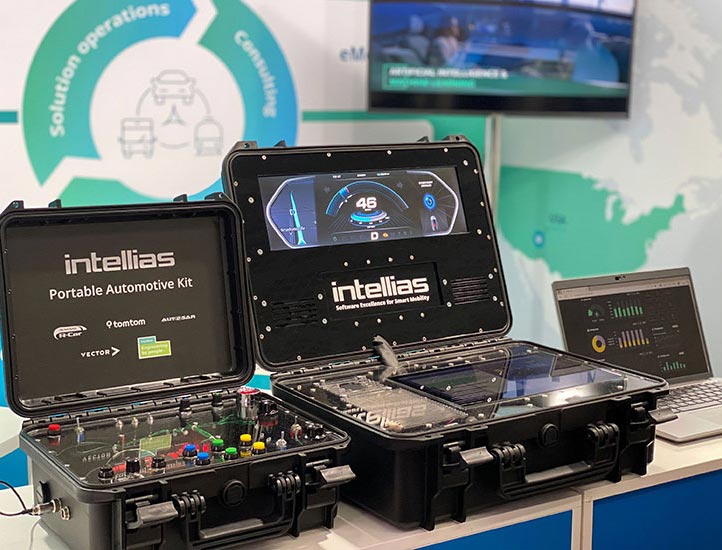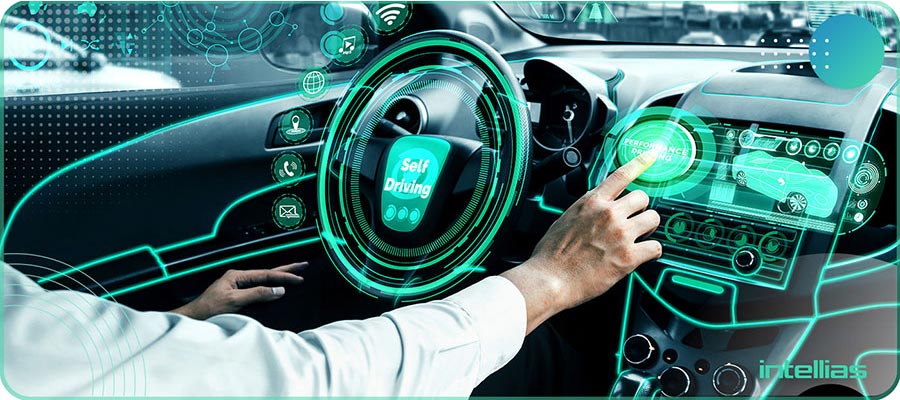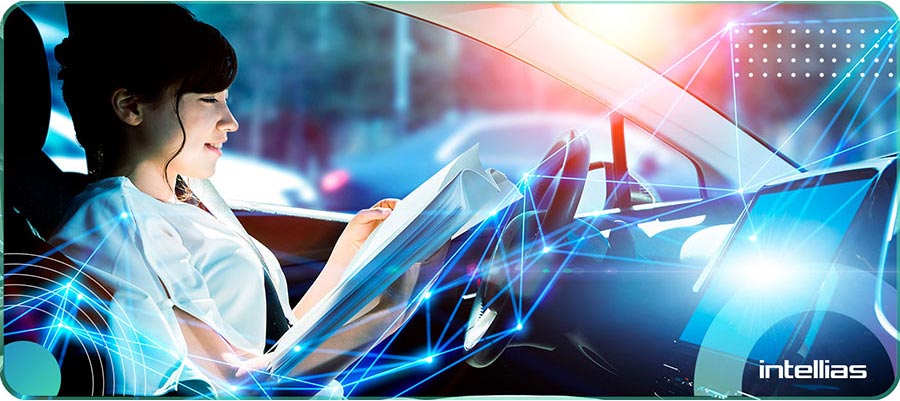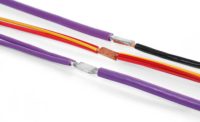Connectivity technology enables cars and trucks to instantly exchange information with other vehicles, devices and infrastructure. It’s a critical component of advanced driver assistance systems, smart roads and unmanned driving.
Automakers around the world, such as Audi, BMW, Ford, General Motors, Tesla and Volvo, are actively pursuing connected car development. So is Intellias. The Ukraine-based company is at the forefront of developing vehicle-to-everything (V2X) technology.
The company recently formed a strategic partnership with Renesas Electronics, a leading manufacturer of semiconductors. The initiative will provide Intellias with an opportunity to showcase its expertise in software-defined vehicles, extended connectivity and digital interfaces.

This portable kit combines automotive-grade hardware provided by Renesas with the high-end digital features of a modern in-vehicle human-machine interface system developed by Intellias. Illustration courtesy Intellias
Working together, the two companies plan to create fully working demos and prototypes of in-vehicle and on-edge systems for OEMs and suppliers. They have already created an Automotive Portable Kit based on the automotive grade R-Car H3e system on chip (SoC), which provides high-end computing power for processing large volumes of vehicle data in real time, making it ideal for a broad range of applications.
Intellias engineers used SoC functionality for in-vehicle infotainment systems and an integrated digital cockpit. It combines automotive-grade hardware provided by Renesas with the high-end digital features of a modern in-vehicle human-machine interface system developed by Intellias.
Currently, both the Renesas and Intellias teams are working closely on the second phase of the Portable Automotive Kit demo to showcase the capabilities of the real-time Arm Cortex-R7 (CR7) processor incorporated into the Renesas R-Car H3e. It will be on display at the upcoming Electronica trade show in Munich.
Intellias has also become a member of Renesas’ automotive ecosystem program, the R-Car Consortium. It’s a network of vendors that reinforce Renesas’ technologies with specific expertise, tools and applications, and promote them in the wider market.
Autonomous and Electric Mobility recently asked Oleksandr Odukha, vice president of delivery at Intellias, to discuss the latest trends in connectivity and V2X technology.

Digital cockpit designs will incorporate more and more V2X features in the future. Illustration courtesy Intellias
AEM: What is the difference between vehicle-to-vehicle (V2V) and vehicle-to-everything (V2X) connectivity? Which technology is closer to being implemented in the real world?
Odukha: The main difference is the scope of communication and the parties involved. V2V connectivity refers to the near-field communication between vehicles exchanging data on the environment around, speed, direction and position. This technology allows vehicles to detect and respond to each other’s presence, enhancing safety and enabling cooperative driving behaviors.
In the heart of V2V connectivity, there are two wireless technologies: dedicated short-range communications (DSRC) and cellular vehicle-to-everything (C-V2X).
V2X connectivity expands communication beyond just vehicles, connecting them to infrastructure (V2I), pedestrians (V2P), cyclists (V2C), and more. In such a way, V2X creates a comprehensive network where vehicles interact with all elements of the mobility ecosystem. For example, V2I enables vehicles to communicate with traffic signals and road infrastructure, while V2P covers communication between vehicles and pedestrians through their mobile devices, increasing safety and awareness.
In the real world, V2V technology depends on less stakeholders, as OEMs are mainly responsible for connectivity features and communication between vehicles on the road. V2V technology has been showcased in various pilot projects. For example, the U.S. Department of Transportation has proposed to use V2V communication frameworks for enhancing roadway safety in large cities.
Compared to V2V technology, V2X is often implemented partly depending on the level of infrastructure development. The full scope of the V2X technology deployment requires much more effort from different parties like governments, legal organizations and technology providers. If implementing it with the right strategy, constantly scaling the scope of technologies involved, V2X holds immense potential for transforming transportation and mobility systems by enabling advanced applications for traffic management, autonomous driving and smart cities.

V2X technology enables vehicles to exchange real-time data to make informed decisions and avoid road incidents. Illustration courtesy Intellias
AEM: Why is V2X technology important to autonomous mobility? How will it enable driverless vehicles to safely operate on roads and highways?
Odukha: V2X technology is essential for autonomous driving, because it enables connectivity between vehicles, whether autonomous or not, road infrastructure and pedestrians. It allows autonomous cars to operate in ever-changing surroundings, navigate efficiently in heavy traffic and enhance the safety of all road movement participants.
V2X technology enables cars to exchange real-time data to make informed decisions and avoid road incidents. It improves traffic flow by allowing vehicles to communicate with traffic management systems, receive optimized routing suggestions and adapt to changing road conditions.
Connectivity enables automated systems to detect pedestrians even when the human eye fails and take fast and responsive actions to ensure people’s safety. V2X also allows real-time updates on weather, road conditions, accidents, road repair, and other potential hazards. Autonomous cars can adjust their routes or driving behavior according to incoming data from connected infrastructure and sensors to improve overall mobility.
AEM: How are recent advancements in ADAS, AI, 5G, cloud computing and other technologies enabling V2X applications?
Odukha: ADAS, 5G, and cloud computing are progressing significantly, thanks to more assessable hardware parts and advancements in vehicle software. ADAS technologies, including sensors like radar and LiDAR, enable accurate detection and tracking of objects for further V2X communication. AI algorithms process and analyze huge volumes of data, supporting faster decision-making and predictive modeling for automated systems.
The high-speed and low-latency capabilities of 5G networks ensure reliable and fast communication between vehicles and infrastructure, while cloud computing provides resources and storage for processing data, and facilitating over-the-air updates. These advancements collectively enable efficient V2X applications, improving situational awareness, decision-making and integration within the mobility ecosystem.
AEM: When do you expect to see V2X technology widely used in passenger vehicles?
Odukha: V2X technology is already on its way to passenger vehicles, and several factors indicate it will become increasingly adopted in the coming years. The first one is automakers’ active position in developing pilot connectivity projects. Secondly, the role of partnerships between OEMs and software providers is growing, which is a good sign that V2X services stay relevant to users’ demands. Furthermore, governments worldwide have shown interest in V2X technology for improving road safety and traffic management. It is reasonable to expect V2X technology to be increasingly used in passenger vehicles within the next five to 10 years. The precise timeline will depend on various factors, including technological advancements, regulatory frameworks, infrastructure development and market adoption.

V2X technology is essential for autonomous driving, because it enables connectivity between vehicles, road infrastructure and pedestrians. Illustration courtesy Intellias
AEM: What type of infrastructure changes will need to take place before V2X technology can be fully deployed?
Odukha: At first, a robust and reliable communication infrastructure must be established, ensuring widespread coverage and low latency connectivity. This requires the deployment of 5G or similar high-speed networks to facilitate seamless V2X communication. Additionally, road infrastructure such as traffic signals, signs and road markings will need to be equipped with V2X capabilities to enable effective communication with vehicles. Public awareness and acceptance of V2X technology will be essential. Public education and demo projects can help build trust and understanding of the benefits and safety enhancements offered by V2X technology.
AEM: What other challenges or hurdles still need to be addressed before V2X technology becomes widely available?
Odukha: Regulations are critical for compatibility and safety across different V2X applications. Establishing guidelines for communication protocols, data privacy and cybersecurity will be crucial in driving the widespread adoption of V2X technology. Another issue is liability concerns about determining the responsibility for accidents or malfunctions. Establishing legal frameworks to handle liability issues will be essential for the broader acceptance of V2X technology.
V2X technology involves exchanging sensitive data, including location information and even payments. Robust data privacy and security measures must be implemented to protect the privacy of individuals and ensure secure communication between vehicles and infrastructure. Also, extensive investments will be required to establish the necessary infrastructure for seamless V2X communication, especially in rural and remote areas. Addressing these challenges will require collaborative efforts from regulatory bodies, industry stakeholders and technology providers to create a supportive ecosystem for the successful implementation of V2X technology on a broader scale.
AEM: What is being done today to address cybersecurity issues related to V2V and V2X connectivity?
Odukha: Cybersecurity actions can be split into two main categories—preventive and corrective. Preventive measures include standardization of protocols, introduction of security guidelines, implementation of the ISO/SAE 21434:2021 automotive cybersecurity standard, wide use of encryption and authentication techniques, collaboration and identification of emerging and potential threats.
Corrective measures require fast and relevant response to unauthorized access, system intrusion and data tampering. Over-the-air updates enable prompt patching of vulnerabilities to secure V2X systems from fraud activities, data leaks, and any other harmful and potentially danger activities. These measures collectively aim to ensure the safety and security of connected vehicles and the overall transportation ecosystem.
AEM: Why has V2X technology been slow to catch on in the U.S. auto industry? Are automakers in Asia and Europe further ahead?
Odukha: V2X technology has faced some challenges in gaining widespread adoption in the United States. One notable reason is the need for more regulations and guidelines governing V2X implementation. The absence of a clear regulatory framework has created uncertainty and slowed down the pace of V2X deployment. Additionally, the size of the U.S. automotive market and the diverse stakeholders involved, including automakers, technology providers and government agencies, can lead to coordination challenges and slower decision-making processes.
On the other hand, The European Union’s Cooperative Intelligent Transport Systems (C-ITS) initiative has driven the development and implementation of V2X systems across the continent. Similarly, Asian countries, particularly China and South Korea, have made significant investments and established ambitious plans for V2X deployment, leveraging government support and collaboration between industry stakeholders.
While the U.S. auto industry has been more cautious in its approach, the recent proposal by the U.S. Department of Transportation to mandate V2V capabilities in new vehicles indicates a growing commitment toward V2X technology. As regulatory frameworks become more defined, the adoption of V2X technology in the U.S. is expected to accelerate, closing the gap with automakers in Asia and Europe.
AEM: What do OEMs need to do today to prepare for V2X connectivity?
Odukha: Automakers can take several steps today to prepare for V2X connectivity:
- Investment in R&D to create unified communication protocols, sensors and in-vehicle systems. This includes exploring partnerships with technology providers and showcasing pilot projects.
- Industry collaborations to develop applicable standards for V2X technology. Collaborating with a wider circle of technology partners, regulatory bodies and infrastructure operators helps establish common standards for better compatibility across different V2X applications.
- Integration of V2X capabilities into the design of new vehicle models, including connectivity modules and sensors, ensuring optimal performance of V2X systems.
- Prioritization of cybersecurity and privacy in V2X communication. Implementing robust encryption, authentication protocols and detection systems helps secure vehicle and user data from cyber threats.
- Rigorous testing and validation of V2X systems are crucial to ensure reliability and performance. OEMs should establish comprehensive testing methods and facilities to evaluate the functionality and safety of V2X technology in real-life scenarios.




